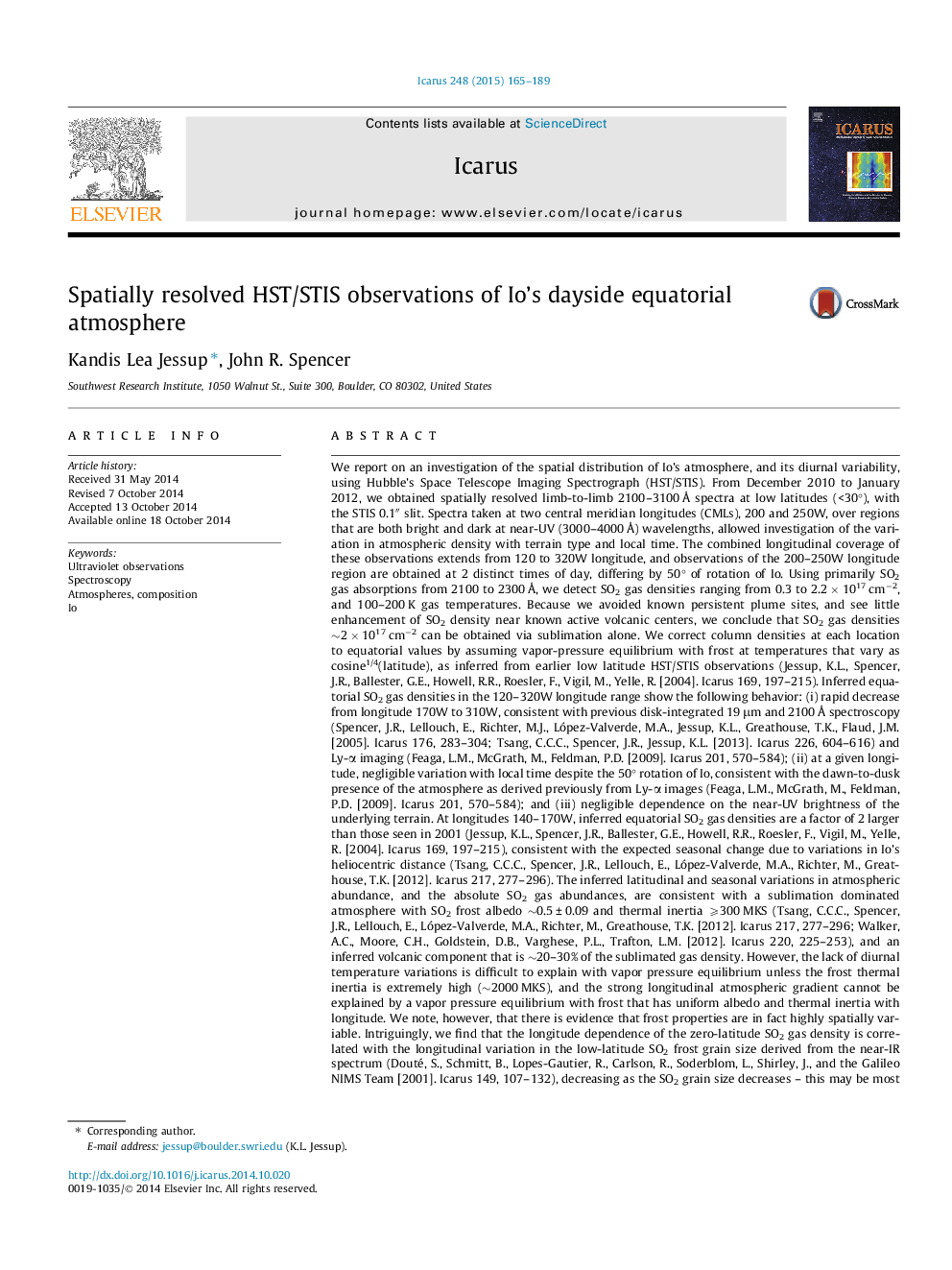| کد مقاله | کد نشریه | سال انتشار | مقاله انگلیسی | نسخه تمام متن |
|---|---|---|---|---|
| 8137014 | 1523542 | 2015 | 25 صفحه PDF | دانلود رایگان |
عنوان انگلیسی مقاله ISI
Spatially resolved HST/STIS observations of Io's dayside equatorial atmosphere
دانلود مقاله + سفارش ترجمه
دانلود مقاله ISI انگلیسی
رایگان برای ایرانیان
کلمات کلیدی
موضوعات مرتبط
مهندسی و علوم پایه
علوم زمین و سیارات
علوم فضا و نجوم
پیش نمایش صفحه اول مقاله

چکیده انگلیسی
We report on an investigation of the spatial distribution of Io's atmosphere, and its diurnal variability, using Hubble's Space Telescope Imaging Spectrograph (HST/STIS). From December 2010 to January 2012, we obtained spatially resolved limb-to-limb 2100-3100Â Ã
spectra at low latitudes (<30°), with the STIS 0.1â³ slit. Spectra taken at two central meridian longitudes (CMLs), 200 and 250W, over regions that are both bright and dark at near-UV (3000-4000 Ã
) wavelengths, allowed investigation of the variation in atmospheric density with terrain type and local time. The combined longitudinal coverage of these observations extends from 120 to 320W longitude, and observations of the 200-250W longitude region are obtained at 2 distinct times of day, differing by 50° of rotation of Io. Using primarily SO2 gas absorptions from 2100 to 2300 Ã
, we detect SO2 gas densities ranging from 0.3 to 2.2 Ã 1017 cmâ2, and 100-200 K gas temperatures. Because we avoided known persistent plume sites, and see little enhancement of SO2 density near known active volcanic centers, we conclude that SO2 gas densities â¼2 Ã 1017 cmâ2 can be obtained via sublimation alone. We correct column densities at each location to equatorial values by assuming vapor-pressure equilibrium with frost at temperatures that vary as cosine1/4(latitude), as inferred from earlier low latitude HST/STIS observations (Jessup, K.L., Spencer, J.R., Ballester, G.E., Howell, R.R., Roesler, F., Vigil, M., Yelle, R. [2004]. Icarus 169, 197-215). Inferred equatorial SO2 gas densities in the 120-320W longitude range show the following behavior: (i) rapid decrease from longitude 170W to 310W, consistent with previous disk-integrated 19 μm and 2100 Ã
spectroscopy (Spencer, J.R., Lellouch, E., Richter, M.J., López-Valverde, M.A., Jessup, K.L., Greathouse, T.K., Flaud, J.M. [2005]. Icarus 176, 283-304; Tsang, C.C.C., Spencer, J.R., Jessup, K.L. [2013]. Icarus 226, 604-616) and Ly-α imaging (Feaga, L.M., McGrath, M., Feldman, P.D. [2009]. Icarus 201, 570-584); (ii) at a given longitude, negligible variation with local time despite the 50° rotation of Io, consistent with the dawn-to-dusk presence of the atmosphere as derived previously from Ly-α images (Feaga, L.M., McGrath, M., Feldman, P.D. [2009]. Icarus 201, 570-584); and (iii) negligible dependence on the near-UV brightness of the underlying terrain. At longitudes 140-170W, inferred equatorial SO2 gas densities are a factor of 2 larger than those seen in 2001 (Jessup, K.L., Spencer, J.R., Ballester, G.E., Howell, R.R., Roesler, F., Vigil, M., Yelle, R. [2004]. Icarus 169, 197-215), consistent with the expected seasonal change due to variations in Io's heliocentric distance (Tsang, C.C.C., Spencer, J.R., Lellouch, E., López-Valverde, M.A., Richter, M., Greathouse, T.K. [2012]. Icarus 217, 277-296). The inferred latitudinal and seasonal variations in atmospheric abundance, and the absolute SO2 gas abundances, are consistent with a sublimation dominated atmosphere with SO2 frost albedo â¼0.5 ± 0.09 and thermal inertia ⩾300 MKS (Tsang, C.C.C., Spencer, J.R., Lellouch, E., López-Valverde, M.A., Richter, M., Greathouse, T.K. [2012]. Icarus 217, 277-296; Walker, A.C., Moore, C.H., Goldstein, D.B., Varghese, P.L., Trafton, L.M. [2012]. Icarus 220, 225-253), and an inferred volcanic component that is â¼20-30% of the sublimated gas density. However, the lack of diurnal temperature variations is difficult to explain with vapor pressure equilibrium unless the frost thermal inertia is extremely high (â¼2000 MKS), and the strong longitudinal atmospheric gradient cannot be explained by a vapor pressure equilibrium with frost that has uniform albedo and thermal inertia with longitude. We note, however, that there is evidence that frost properties are in fact highly spatially variable. Intriguingly, we find that the longitude dependence of the zero-latitude SO2 gas density is correlated with the longitudinal variation in the low-latitude SO2 frost grain size derived from the near-IR spectrum (Douté, S., Schmitt, B., Lopes-Gautier, R., Carlson, R., Soderblom, L., Shirley, J., and the Galileo NIMS Team [2001]. Icarus 149, 107-132), decreasing as the SO2 grain size decreases - this may be most plausibly explained by an increase in frost albedo, and thus a reduction in temperature and vapor pressure, with decreasing grain size. We further note that the densest regions of Io's atmosphere are correlated in both latitude and longitude with regions characterized by both large SO2 grain size and unusual photometric properties, and suggest that frost albedo may be particularly low in these regions. In addition to the gas densities, SO2 continuum emission was detected 0.28 μm ranging in brightness from ⩽0.004 to 1.17 kRy/Ã
. The emission brightness was observed to increase as the fitted SO2 gas density increased, but the variance in the emission brightness appears to be more strongly correlated with the relative proximity to the anti-jovian magnetic reconnection point.
ناشر
Database: Elsevier - ScienceDirect (ساینس دایرکت)
Journal: Icarus - Volume 248, 1 March 2015, Pages 165-189
Journal: Icarus - Volume 248, 1 March 2015, Pages 165-189
نویسندگان
Kandis Lea Jessup, John R. Spencer,